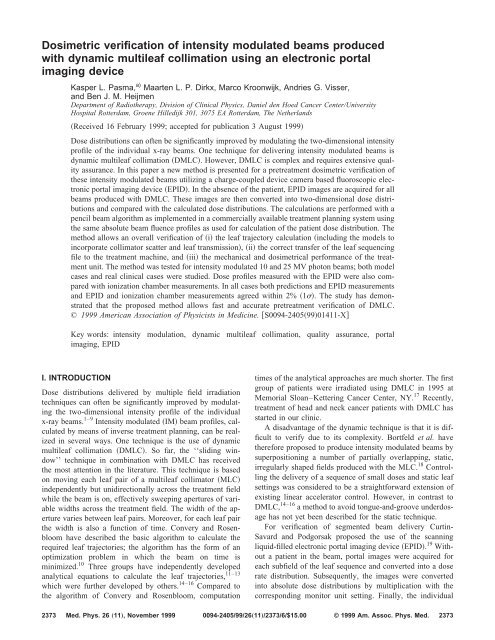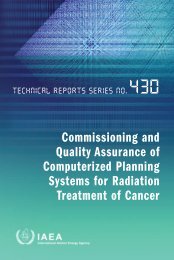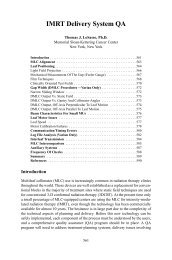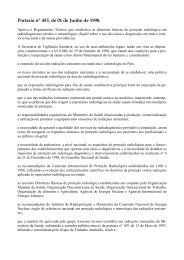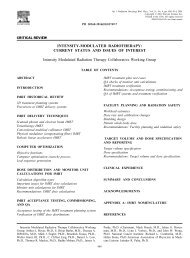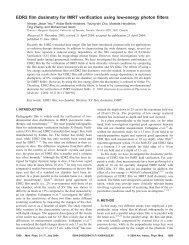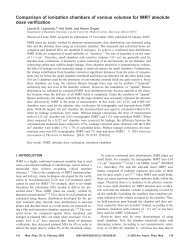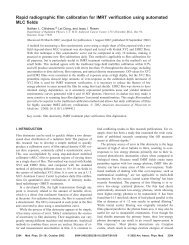Dosimetric verification of intensity modulated beams produced with ...
Dosimetric verification of intensity modulated beams produced with ...
Dosimetric verification of intensity modulated beams produced with ...
You also want an ePaper? Increase the reach of your titles
YUMPU automatically turns print PDFs into web optimized ePapers that Google loves.
<strong>Dosimetric</strong> <strong>verification</strong> <strong>of</strong> <strong>intensity</strong> <strong>modulated</strong> <strong>beams</strong> <strong>produced</strong><br />
<strong>with</strong> dynamic multileaf collimation using an electronic portal<br />
imaging device<br />
Kasper L. Pasma, a) Maarten L. P. Dirkx, Marco Kroonwijk, Andries G. Visser,<br />
and Ben J. M. Heijmen<br />
Department <strong>of</strong> Radiotherapy, Division <strong>of</strong> Clinical Physics, Daniel den Hoed Cancer Center/University<br />
Hospital Rotterdam, Groene Hilledijk 301, 3075 EA Rotterdam, The Netherlands<br />
Received 16 February 1999; accepted for publication 3 August 1999<br />
Dose distributions can <strong>of</strong>ten be significantly improved by modulating the two-dimensional <strong>intensity</strong><br />
pr<strong>of</strong>ile <strong>of</strong> the individual x-ray <strong>beams</strong>. One technique for delivering <strong>intensity</strong> <strong>modulated</strong> <strong>beams</strong> is<br />
dynamic multileaf collimation DMLC. However, DMLC is complex and requires extensive quality<br />
assurance. In this paper a new method is presented for a pretreatment dosimetric <strong>verification</strong> <strong>of</strong><br />
these <strong>intensity</strong> <strong>modulated</strong> <strong>beams</strong> utilizing a charge-coupled device camera based fluoroscopic electronic<br />
portal imaging device EPID. In the absence <strong>of</strong> the patient, EPID images are acquired for all<br />
<strong>beams</strong> <strong>produced</strong> <strong>with</strong> DMLC. These images are then converted into two-dimensional dose distributions<br />
and compared <strong>with</strong> the calculated dose distributions. The calculations are performed <strong>with</strong> a<br />
pencil beam algorithm as implemented in a commercially available treatment planning system using<br />
the same absolute beam fluence pr<strong>of</strong>iles as used for calculation <strong>of</strong> the patient dose distribution. The<br />
method allows an overall <strong>verification</strong> <strong>of</strong> i the leaf trajectory calculation including the models to<br />
incorporate collimator scatter and leaf transmission, ii the correct transfer <strong>of</strong> the leaf sequencing<br />
file to the treatment machine, and iii the mechanical and dosimetrical performance <strong>of</strong> the treatment<br />
unit. The method was tested for <strong>intensity</strong> <strong>modulated</strong> 10 and 25 MV photon <strong>beams</strong>; both model<br />
cases and real clinical cases were studied. Dose pr<strong>of</strong>iles measured <strong>with</strong> the EPID were also compared<br />
<strong>with</strong> ionization chamber measurements. In all cases both predictions and EPID measurements<br />
and EPID and ionization chamber measurements agreed <strong>with</strong>in 2% 1. The study has demonstrated<br />
that the proposed method allows fast and accurate pretreatment <strong>verification</strong> <strong>of</strong> DMLC.<br />
© 1999 American Association <strong>of</strong> Physicists in Medicine. S0094-24059901411-X<br />
Key words: <strong>intensity</strong> modulation, dynamic multileaf collimation, quality assurance, portal<br />
imaging, EPID<br />
I. INTRODUCTION<br />
Dose distributions delivered by multiple field irradiation<br />
techniques can <strong>of</strong>ten be significantly improved by modulating<br />
the two-dimensional <strong>intensity</strong> pr<strong>of</strong>ile <strong>of</strong> the individual<br />
x-ray <strong>beams</strong>. 1–9 Intensity <strong>modulated</strong> IM beam pr<strong>of</strong>iles, calculated<br />
by means <strong>of</strong> inverse treatment planning, can be realized<br />
in several ways. One technique is the use <strong>of</strong> dynamic<br />
multileaf collimation DMLC. So far, the ‘‘sliding window’’<br />
technique in combination <strong>with</strong> DMLC has received<br />
the most attention in the literature. This technique is based<br />
on moving each leaf pair <strong>of</strong> a multileaf collimator MLC<br />
independently but unidirectionally across the treatment field<br />
while the beam is on, effectively sweeping apertures <strong>of</strong> variable<br />
widths across the treatment field. The width <strong>of</strong> the aperture<br />
varies between leaf pairs. Moreover, for each leaf pair<br />
the width is also a function <strong>of</strong> time. Convery and Rosenbloom<br />
have described the basic algorithm to calculate the<br />
required leaf trajectories; the algorithm has the form <strong>of</strong> an<br />
optimization problem in which the beam on time is<br />
minimized. 10 Three groups have independently developed<br />
analytical equations to calculate the leaf trajectories, 11–13<br />
which were further developed by others. 14–16 Compared to<br />
the algorithm <strong>of</strong> Convery and Rosenbloom, computation<br />
times <strong>of</strong> the analytical approaches are much shorter. The first<br />
group <strong>of</strong> patients were irradiated using DMLC in 1995 at<br />
Memorial Sloan–Kettering Cancer Center, NY. 17 Recently,<br />
treatment <strong>of</strong> head and neck cancer patients <strong>with</strong> DMLC has<br />
started in our clinic.<br />
A disadvantage <strong>of</strong> the dynamic technique is that it is difficult<br />
to verify due to its complexity. Bortfeld et al. have<br />
therefore proposed to produce <strong>intensity</strong> <strong>modulated</strong> <strong>beams</strong> by<br />
superpositioning a number <strong>of</strong> partially overlapping, static,<br />
irregularly shaped fields <strong>produced</strong> <strong>with</strong> the MLC. 18 Controlling<br />
the delivery <strong>of</strong> a sequence <strong>of</strong> small doses and static leaf<br />
settings was considered to be a straightforward extension <strong>of</strong><br />
existing linear accelerator control. However, in contrast to<br />
DMLC, 14–16 a method to avoid tongue-and-groove underdosage<br />
has not yet been described for the static technique.<br />
For <strong>verification</strong> <strong>of</strong> segmented beam delivery Curtin-<br />
Savard and Podgorsak proposed the use <strong>of</strong> the scanning<br />
liquid-filled electronic portal imaging device EPID. 19 Without<br />
a patient in the beam, portal images were acquired for<br />
each subfield <strong>of</strong> the leaf sequence and converted into a dose<br />
rate distribution. Subsequently, the images were converted<br />
into absolute dose distributions by multiplication <strong>with</strong> the<br />
corresponding monitor unit setting. Finally, the individual<br />
2373 Med. Phys. 26 „11…, November 1999 0094-2405/99/26„11…/2373/6/$15.00 © 1999 Am. Assoc. Phys. Med. 2373
2374 Pasma et al.: <strong>Dosimetric</strong> <strong>verification</strong> <strong>of</strong> <strong>intensity</strong> <strong>modulated</strong> <strong>beams</strong> using an EPID 2374<br />
dose distributions were summed to produce a dose distribution<br />
at the measurement depth. These distributions were then<br />
compared <strong>with</strong> dose distributions predicted by a treatment<br />
planning system. Because <strong>of</strong> the use <strong>of</strong> the monitor unit setting,<br />
the comparison <strong>with</strong> the dose distribution <strong>of</strong> the planning<br />
system is basically a <strong>verification</strong> <strong>of</strong> the relative dose<br />
distribution. The applied EPID is relatively slow in returning<br />
to the initial state. Therefore, they had to apply a 60 s rest<br />
interval between measurement <strong>of</strong> subsequent segments,<br />
yielding long overall measurement times <strong>of</strong> typically 1 h.<br />
Due to the scanned signal readout and the measurement <strong>of</strong><br />
dose rate instead <strong>of</strong> dose, the applied EPID is not suitable for<br />
high precision dosimetric <strong>verification</strong> <strong>of</strong> DMLC.<br />
To test the reproducibility and accuracy <strong>of</strong> DMLC, the<br />
use <strong>of</strong> film has been reported. 20–22 At Memorial Sloan–<br />
Kettering Cancer Center film dosimetry is performed in a flat<br />
homogeneous phantom for each field prior to the first treatment.<br />
Measured dose distributions are compared <strong>with</strong> corresponding<br />
calculated dose distributions. 22 A disadvantage <strong>of</strong><br />
film dosimetry is that it is time consuming since it requires<br />
developing and scanning <strong>of</strong> the film, furthermore a sensitometric<br />
curve is needed to convert optical densities into doses.<br />
Charge-coupled device CCD camera based EPIDs are a<br />
promising tool for <strong>verification</strong> <strong>of</strong> DMLC due to their high<br />
data acquisition rate and capability to measure simultaneously<br />
in all points <strong>of</strong> the treatment field. 23–26 Balter et al.<br />
showed preliminary results <strong>of</strong> a method to derive leaf positions<br />
in each camera frame acquired during treatment and to<br />
compare them <strong>with</strong> a table <strong>of</strong> prescribed leaf positions. 26<br />
Leaf positions could be determined <strong>with</strong> an accuracy <strong>of</strong> 0.6<br />
mm and a duty cycle <strong>of</strong> less than 1 s. A similar approach was<br />
implemented by Partridge et al. 25 They used a custom-made<br />
EPID <strong>with</strong> image acquisition synchronized to the accelerator<br />
magnetron current pulse production, <strong>with</strong> one CCD camera<br />
frame acquired per accelerator pulse. Data were presented<br />
for a 6 MV beam. The accuracy <strong>of</strong> the leaf position measurements<br />
was 2 mm. Due to a limitation <strong>of</strong> the camera triggering<br />
hardware the pulse rate <strong>of</strong> the linac had to be reduced.<br />
Ma et al. calculated normalized reference images from MLC<br />
leaf sequencing files and compared these <strong>with</strong> normalized<br />
images measured <strong>with</strong> a fluoroscopic beam imaging system<br />
BIS, Wellhöfer Dosimetrie, Schwarzenbruck, Germany for<br />
a 6 MV photon beam. 24 This imaging system can be fastened<br />
to the blocking tray holder <strong>of</strong> a linear accelerator. It was<br />
especially designed for quality control tasks. For the calculation<br />
<strong>of</strong> the reference images a measured portal image <strong>of</strong> a<br />
large open field was used. The reference images were therefore<br />
not only related to the prescribed fluence, but also contained<br />
optical distortions in the EPID system. A global correlation<br />
coefficient was used to compare the calculated<br />
reference image <strong>with</strong> the image measured <strong>with</strong> the BIS system.<br />
This method can be used to verify whether the leaf<br />
sequencing files have been transferred correctly to the linac<br />
control computer and whether the treatment can be correctly<br />
executed <strong>with</strong>out machine faults. Transmission through the<br />
leaves both intraleaf and interleaf was not taken into account<br />
and a simple empirical method was used to model<br />
extrafocal scatter. Despite these limitations, they concluded<br />
that it was possible to detect uncertainties <strong>of</strong> less than 0.5<br />
mm in leaf position during DMLC.<br />
The above described methods to verify leaf motion cannot<br />
be used to check whether the calculated leaf trajectories do<br />
indeed generate the absolute beam fluence pr<strong>of</strong>iles used in<br />
treatment planning. In this paper a new method is presented<br />
for a pretreatment <strong>verification</strong> <strong>of</strong> these absolute beam fluence<br />
pr<strong>of</strong>iles utilizing a commercially available CCD camera<br />
based fluoroscopic EPID. In the absence <strong>of</strong> the patient, EPID<br />
images are acquired for all <strong>beams</strong> <strong>produced</strong> <strong>with</strong> DMLC.<br />
These images are then converted into two-dimensional dose<br />
distributions and compared <strong>with</strong> calculated dose distributions.<br />
The calculations are performed <strong>with</strong> a pencil beam<br />
algorithm as implemented in a commercially available treatment<br />
planning system TPS using the same absolute beam<br />
fluence pr<strong>of</strong>iles as used in the TPS for calculation <strong>of</strong> the<br />
patient dose distributions. In this paper results are presented<br />
for <strong>intensity</strong> <strong>modulated</strong> 10 and 25 MV photon <strong>beams</strong>; both<br />
model cases and real clinical cases were studied. Absolute<br />
dose pr<strong>of</strong>iles measured <strong>with</strong> the EPID were also compared<br />
<strong>with</strong> ionization chamber measurements. Preliminary results<br />
on measurements <strong>of</strong> absolute dose distributions in IM fields<br />
<strong>produced</strong> <strong>with</strong> DMLC have been reported. 23<br />
II. MATERIALS AND METHODS<br />
A. EPID and ionization chamber dose measurements<br />
The applied EPID was a Philips SRI-100 Philips Medical<br />
Systems, Crawley, UK, which basically consists <strong>of</strong> a fluorescent<br />
screen, two mirrors, and a CCD camera. The fluorescent<br />
screen is a 1.65-mm-thick stainless steel plate coated<br />
<strong>with</strong> a layer <strong>of</strong> gadolinium oxysulphide. To reduce the detection<br />
<strong>of</strong> high-energy electrons generated in patients, an extra<br />
1-mm-thick stainless steel slab has been mounted on the<br />
standard fluorescent screen. 23 The added slab hardly affects<br />
the image quality. 27 The acquired images may be used both<br />
for setup <strong>verification</strong> and for in vivo dosimetry. 28 The EPID<br />
has a fixed focus to fluorescent screen distance <strong>of</strong> 160 cm.<br />
Technical details <strong>of</strong> the EPID have been described by Visser<br />
et al. and Alth<strong>of</strong> et al. 29,30<br />
Image acquisition is performed <strong>with</strong> a procedure written<br />
in the macro command language that comes <strong>with</strong> the system.<br />
The integration time on the CCD chip was set to 240 ms and<br />
120 camera frames were accumulated in the frame store<br />
memory. The readout time needed to transmit a frame from<br />
the CCD to the frame grabber during which no signal is<br />
accumulated is 80 ms. The final image is the mean <strong>of</strong> the<br />
integrated camera frames, corrected for the dark current measured<br />
prior to the irradiation. In the original procedure image<br />
acquisition starts automatically when the measured pixel values<br />
in the center <strong>of</strong> the camera frame exceed a threshold, i.e.,<br />
when the beam is switched on. For the DMLC measurements<br />
described in this paper image acquisition was started manually,<br />
since <strong>with</strong> the sliding window technique the pixels in<br />
the center <strong>of</strong> the image are blocked by the leaves when the<br />
irradiation starts. The procedure is discussed in detail in another<br />
paper. 23<br />
Medical Physics, Vol. 26, No. 11, November 1999
2375 Pasma et al.: <strong>Dosimetric</strong> <strong>verification</strong> <strong>of</strong> <strong>intensity</strong> <strong>modulated</strong> <strong>beams</strong> using an EPID 2375<br />
Due to sagging <strong>of</strong> the EPID structure the field center can<br />
shift slightly. To correct the image for this shift the position<br />
<strong>of</strong> the field center was derived using the position <strong>of</strong> the field<br />
borders in an EPID image <strong>of</strong> a static square field, which is<br />
stored in a lookup table. The raw EPID images <strong>of</strong> 512256<br />
pixels were then resampled to arrays <strong>of</strong> 6464 elements;<br />
each element represents a region <strong>of</strong> interest <strong>with</strong> an area <strong>of</strong><br />
0.50.5 cm 2 projected at isocenter. Conversion <strong>of</strong> these arrays<br />
into absolute dose distributions was performed in three<br />
steps. Acquired images were first corrected for the nonlinear<br />
response <strong>of</strong> the system. 23,31 Subsequently, the image was<br />
corrected for the optical ‘‘cross talk’’ by deconvolving it<br />
<strong>with</strong> a point spread function. 23,32 Finally, the resulting array<br />
was divided by an array that accounts for relative EPID<br />
sensitivity. 23 The system was calibrated once. The observed<br />
day-to-day variation <strong>of</strong> the EPID response per unit <strong>of</strong> delivered<br />
dose is 0.4% (1). 32 Due to radiation damage to the<br />
CCD chip the EPID response gradually decreases<br />
(3%/yr. 33 This decrease was carefully monitored and corrected<br />
for using the daily acquired images for the quality<br />
control <strong>of</strong> the absolute output and field flatness <strong>of</strong> the scanning<br />
photon <strong>beams</strong> <strong>of</strong> the MM50 34 and the two weekly output<br />
checks <strong>with</strong> an ionization chamber.<br />
Dose measurements were also performed <strong>with</strong> a N31002<br />
ionization chamber PTW, Freiburg, Germany. The ionization<br />
chamber was inserted in a polystyrene miniphantom 35 at<br />
a depth <strong>of</strong> 2.0 cm for the 10 MV beam and at 2.5 cm for the<br />
25 MV beam. For those depths it was experimentally found<br />
that the variations in the on-axis response <strong>of</strong> the EPID EPID<br />
pixel value/portal dose measured <strong>with</strong> the ionization chamber<br />
(G/D p ) were minimal for field sizes ranging from 33<br />
up to 1818 cm 2 and polystyrene absorber thicknesses ranging<br />
from zero up to 35 cm. For a 25 MV photon beam the<br />
mean <strong>of</strong> the standard deviations <strong>of</strong> the EPID response for all<br />
field sizes was 0.4%. 23 The miniphantom was scanned in an<br />
empty RFA-300 water phantom Scanditronix Medical AB,<br />
Uppsala, Sweden <strong>with</strong> the center <strong>of</strong> the ionization chamber<br />
positioned at a distance <strong>of</strong> 160 cm from the focus, which is<br />
equal to the fixed focus to fluorescent screen distance <strong>of</strong> the<br />
EPID.<br />
B. Calculation <strong>of</strong> the dose distribution at the detector<br />
The starting point for the calculation <strong>of</strong> the dose distribution<br />
at the fluorescent screen <strong>of</strong> the detector is the optimized<br />
beam fluence F opt (x,y) in monitor units MU to be delivered<br />
at position (x,y), which is the result <strong>of</strong> a computer<br />
optimization or inverse treatment planning. A fluence <strong>of</strong> 1<br />
MU corresponds to the fluence due to an irradiation that<br />
results in a dose delivery <strong>of</strong> 1 cGy at a depth <strong>of</strong> dose maximum<br />
in water <strong>with</strong> a source surface distance SSD <strong>of</strong> 100<br />
cm in a static 1010 cm 2 field. Using an iterative algorithm<br />
described by Dirkx et al., leaf trajectories are then calculated<br />
taking into account collimator scatter and the effective leaf<br />
transmission, which is the sum <strong>of</strong> the transmission through<br />
the leaves and the extra focal radiation under the moving<br />
leaves. 15 The algorithm fully avoids tongue-and-groove underdosage<br />
effects. 14 Generally less than ten iterations are<br />
necessary to minimize the difference between optimized<br />
F opt (x,y) and realized fluence pr<strong>of</strong>iles F(x,y), which<br />
are used for calculation <strong>of</strong> the final dose distribution in the<br />
patient <strong>with</strong> the CadPlan 3D TPS Varian-Dosetek, Espoo,<br />
Finland.<br />
The expected absolute dose distribution in the plane <strong>of</strong> the<br />
fluorescent screen <strong>of</strong> the EPID, D p,0 (x,y), is calculated from<br />
the realized fluence pr<strong>of</strong>ile using the pencil beam algorithm<br />
as implemented in the CadPlan TPS. 36,37 In the current<br />
implementation CadPlan v2.7.9 the penumbra width is a<br />
linear function <strong>of</strong> the SSD. As a result the predicted dose<br />
distributions would become inaccurate for the SSD <strong>of</strong> the<br />
detector 160 cm, which is much larger than the SSDs clinically<br />
used. Therefore, the dose distribution is calculated at<br />
100 cm from the focus by enlarging the field <strong>with</strong> a factor <strong>of</strong><br />
1.6 160/100. The dose distribution is then normalized using<br />
the calculated on-axis dose in a static 1616 cm 2 field for<br />
150 MU. Finally, the absolute dose distribution is calculated<br />
using the measured cGy/MU value at the detector for a<br />
1010 cm 2 field. Dose calculations and the calibration measurement<br />
are performed at a water depth <strong>of</strong> 2 cm for the 10<br />
MV photon beam and at a depth <strong>of</strong> 2.5 cm for the 25 MV<br />
beam, equal to the effective measuring depths <strong>of</strong> the EPID,<br />
as discussed in Sec. II A.<br />
C. Realization and <strong>verification</strong> <strong>of</strong> fluence pr<strong>of</strong>iles<br />
Measured and predicted dose distributions D p,0 (x,y) were<br />
compared for the 10 and 25 MV photon <strong>beams</strong> <strong>of</strong> the MM50<br />
racetrack microtron Scanditronix Medical AB, Uppsala,<br />
Sweden. The dose rate was 200 MU min 1 for the 10 MV<br />
beam and 300 MU min 1 for the 25 MV beam. The microtron<br />
produces 200 radiation pulses per second pps. The<br />
unit is equipped <strong>with</strong> a double-focused multileaf collimator<br />
<strong>with</strong> 32 leaf pairs. Projected at isocenter the leaf width is<br />
1.25 cm. The maximum leaf speed is 1 cm s 1 . For all measurements<br />
the leaves moved from left to right parallel to the<br />
x axis. During DMLC, every 50 ms the accelerator control<br />
system compares the actual leaf positions, measured <strong>with</strong><br />
potentiometers, <strong>with</strong> the prescribed positions. If the deviation<br />
between a prescribed and a measured position is more than<br />
0.2 cm during three subsequent checks, the irradiation is interrupted.<br />
Realization <strong>of</strong> IM fluence pr<strong>of</strong>iles <strong>with</strong> this unit is<br />
discussed in detail elsewhere. 15<br />
The developed method was tested for a range <strong>of</strong> fluence<br />
pr<strong>of</strong>iles, both model cases and real clinical cases were studied.<br />
Calculated absolute dose distributions Sec. II B were<br />
compared <strong>with</strong> dose distributions derived from EPID images<br />
and <strong>with</strong> dose pr<strong>of</strong>iles measured <strong>with</strong> an ionization chamber<br />
Sec. II A. The axes for comparisons in the leaf direction<br />
were chosen at the center <strong>of</strong> each leaf pair (y0.6,1.9,<br />
3.1,...). Throughout the paper, positions and distances are<br />
defined at the plane normal to the beam axis at 100 cm from<br />
the focus. The reported differences are the mean deviation in<br />
percent and the corresponding standard deviation in percent<br />
mean 1 %.<br />
Medical Physics, Vol. 26, No. 11, November 1999
2376 Pasma et al.: <strong>Dosimetric</strong> <strong>verification</strong> <strong>of</strong> <strong>intensity</strong> <strong>modulated</strong> <strong>beams</strong> using an EPID 2376<br />
FIG. 1. Predicted line and measured absolute dose —EPID,<br />
—ionization chamber along the y0.6 cm axis for a wedge pr<strong>of</strong>ile <strong>produced</strong><br />
<strong>with</strong> DMLC using the 10 MV photon beam.<br />
III. RESULTS<br />
In Figs. 1 and 2 data are presented for <strong>intensity</strong> <strong>modulated</strong><br />
10 MV <strong>beams</strong>. Within the treatment field the leaf trajectories<br />
were identical for all leaf pairs; the presented data are for y<br />
0.6 cm. Outside the penumbra, there is an excellent agreement<br />
between EPID and ionization chamber measurements<br />
EPID-ionization chamber/ionization chamber for both<br />
<strong>beams</strong>: 0.30.6% Fig. 1 and 0.10.8% Fig. 2. The actual<br />
agreement may even be slightly better, since each ionization<br />
chamber measurement required the complete irradiation to<br />
be repeated. The short term reproducibility <strong>of</strong> the absolute<br />
dose delivery <strong>with</strong> DMLC at the MM50 racetrack microtron<br />
is 0.2%. 38 The deviations between the calculated dose pr<strong>of</strong>ile<br />
and the pr<strong>of</strong>ile measured <strong>with</strong> the EPID are 2.11.2% and<br />
0.90.8%, respectively.<br />
The data presented in Fig. 3 are for a beam fluence pr<strong>of</strong>ile<br />
that was also used to generate the data in Fig. 2, but now<br />
realized <strong>with</strong> the 25 MV beam. Again deviations between<br />
EPID and ionization chamber measurements are small: 0.2<br />
1.3%. The deviation between the predicted dose pr<strong>of</strong>ile<br />
and the pr<strong>of</strong>ile measured <strong>with</strong> the EPID is 1.00.7%.<br />
Similar results were found for the pr<strong>of</strong>ile presented in Fig. 4:<br />
0.21.0% and 1.01.4%, respectively.<br />
In Figs. 5a and 5b acquired EPID images 512256<br />
pixels for two nonsquare IM 25 MV <strong>beams</strong> are shown. The<br />
fluence decreases in the y direction; the dose at the top <strong>of</strong> the<br />
image is a factor <strong>of</strong> 2.2 lower than at the bottom. Due to the<br />
FIG. 3. Predicted line and measured absolute dose —EPID,<br />
—ionization chamber along the y0.6 cm axis for an IM 25 MV beam.<br />
synchronization <strong>of</strong> leaf trajectories <strong>of</strong> adjacent leaves, underdosages<br />
lower pixel values do not occur in the overlap<br />
regions. 14 The small overdosages higher pixel values in the<br />
overlap regions <strong>of</strong> adjacent leaves are due to the interleaf<br />
leakage <strong>of</strong> about 2%. 15 These overdosages can be avoided<br />
using partial synchronization. 16 Figures 5c and 5d show<br />
cross sections along the y axis normal to the axis along<br />
which the leaves move <strong>of</strong> the two-dimensional dose pr<strong>of</strong>ile<br />
derived from the EPID images shown in Figs. 5a and 5b.<br />
Corresponding predicted dose pr<strong>of</strong>iles and dose pr<strong>of</strong>iles measured<br />
<strong>with</strong> an ionization chamber are included. For the first<br />
field Fig. 5a the deviation between EPID and ionization<br />
chamber measurements was 0.21.1% and for the second<br />
field Fig. 5b 0.42.0%. The deviations between the predicted<br />
pr<strong>of</strong>ile and the EPID measurements were 0.91.7%<br />
and 1.41.7%, respectively. Standard deviations are<br />
slightly increased due to the interleaf leakage that was measured<br />
but not taken into account in the calculations. Under<br />
the center <strong>of</strong> the leaves the deviations are 0.71.2% and<br />
0.41.6%, respectively.<br />
In Fig. 6 results are presented for a two-dimensional IM<br />
pr<strong>of</strong>ile designed for treatment <strong>of</strong> a prostate cancer patient.<br />
The deviation between the predicted pr<strong>of</strong>ile and the pr<strong>of</strong>ile<br />
measured <strong>with</strong> the EPID is 0.51.1%.<br />
IV. DISCUSSION AND CONCLUSIONS<br />
A procedure for pretreatment <strong>verification</strong> <strong>of</strong> absolute<br />
beam fluence pr<strong>of</strong>iles realized <strong>with</strong> DMLC was developed<br />
FIG. 2. Predicted line and measured absolute dose —EPID,<br />
—ionization chamber along the y0.6 cm axis for an IM 10 MV beam.<br />
FIG. 4. Predicted line and measured absolute dose —EPID,<br />
—ionization chamber along the y0.6 cm line for an IM 25 MV beam.<br />
Medical Physics, Vol. 26, No. 11, November 1999
2377 Pasma et al.: <strong>Dosimetric</strong> <strong>verification</strong> <strong>of</strong> <strong>intensity</strong> <strong>modulated</strong> <strong>beams</strong> using an EPID 2377<br />
FIG. 5. Raw EPID images <strong>of</strong> IM 25 MV photon <strong>beams</strong> are shown in a and b. Inc and d the corresponding measured —EPID, —ionization<br />
chamber and predicted line absolute dose pr<strong>of</strong>iles along the y axis normal to the axis along which the leaves move are shown.<br />
FIG. 6. Predicted lines and <strong>with</strong> the EPID measured absolute dose<br />
pr<strong>of</strong>iles along the y1.9 cm axis <strong>of</strong> a lateral IM 25 MV photon beam for<br />
a prostate cancer patient.<br />
and tested. The time required to verify an IM beam is about<br />
2 min, which is much shorter than any other dosimetric technique.<br />
The EPID system only has to be calibrated once. The<br />
agreement between calculations and EPID measurements<br />
and between EPID and ionization chamber measurements<br />
was <strong>with</strong>in 2% (1). The procedure allows an overall <strong>verification</strong><br />
<strong>of</strong> i the leaf trajectory calculation including the<br />
models to incorporate collimator scatter and leaf transmission,<br />
ii the correct transfer <strong>of</strong> the leaf sequencing file to the<br />
treatment machine, and iii the mechanical and dosimetrical<br />
performance <strong>of</strong> the treatment unit. It is not always possible to<br />
distinguish between these types <strong>of</strong> errors using only portal<br />
images. Previously published DMLC <strong>verification</strong> methods<br />
<strong>with</strong> EPIDs only verified leaf motion 25,26 or relative dose<br />
pr<strong>of</strong>iles. 24 The excellent agreement between EPID and ionization<br />
chamber measurements in all cases shows that the<br />
readout time <strong>of</strong> 80 ms during which no signal is collected<br />
has no detectable effect; the data acquisition rate is sufficiently<br />
high. 24<br />
In the near future the developed method will be extended<br />
to enable <strong>verification</strong> <strong>of</strong> DMLC during patient treatment. Acquisition<br />
<strong>of</strong> portal images suitable for dosimetric <strong>verification</strong><br />
<strong>of</strong> DMLC can be fully integrated into existing imaging routines<br />
for patient setup <strong>verification</strong>, <strong>with</strong>out introducing an<br />
increase in the overall treatment time. 28 Preliminary results<br />
on measurements <strong>of</strong> portal dose images PDI, i.e., the dose<br />
distribution behind a patient in a plane normal to the beam<br />
axis, in an IM beam have been reported. 23 The calculation <strong>of</strong><br />
a PDI for a patient irradiated <strong>with</strong> an IM beam is a relatively<br />
simple extension <strong>of</strong> existing methods. 35 The relation is<br />
D p (x,y)D p,0 (x,y)T(x,y), <strong>with</strong> D p (x,y) the predicted<br />
portal dose at position (x,y) beneath the patient, D p,0 (x,y)<br />
the predicted portal dose in absence <strong>of</strong> the patient as described<br />
in Sec. II B, and T(x,y) the predicted transmission<br />
through the patient using the planning CT data. The method<br />
for calculation <strong>of</strong> these transmission functions has been described<br />
elsewhere. A potential problem is to distinguish between<br />
deviations in predicted and measured PDIs due to machine<br />
faults and differences due to deviations between the<br />
patient anatomy during acquisition <strong>of</strong> the planning CT scan<br />
and during treatment. For prostate cancer patients we have<br />
observed that deviations in patient anatomy introduce large<br />
local differences between predicted and measured PDIs. 28<br />
Machine faults are likely to produce a constant difference<br />
over the whole irradiation field. In case <strong>of</strong> malfunctioning <strong>of</strong><br />
Medical Physics, Vol. 26, No. 11, November 1999
2378 Pasma et al.: <strong>Dosimetric</strong> <strong>verification</strong> <strong>of</strong> <strong>intensity</strong> <strong>modulated</strong> <strong>beams</strong> using an EPID 2378<br />
a single leaf, the difference will be limited to the beam’s eye<br />
view <strong>of</strong> that leaf.<br />
ACKNOWLEDGMENTS<br />
The authors would like to thank Gert-Jan van de Pol for<br />
his help <strong>with</strong> the measurements. This work was financially<br />
supported by the Dutch Cancer Society Grants Nos. DDHK<br />
94-848 and 98-1681.<br />
a Electronic mail: pasma@kfih.azr.nl<br />
1 T. Bortfeld, J. Bürkelbach, R. Boesecke, and W. Schlegel, ‘‘Methods <strong>of</strong><br />
image reconstruction from projections applied to conformation radiotherapy,’’<br />
Phys. Med. Biol. 35, 1423–1443 1990.<br />
2 A. Brahme, J. E. Roos, and I. Lax, ‘‘Solution <strong>of</strong> an integral equation<br />
encountered in rotation therapy,’’ Phys. Med. Biol. 27, 1221–1229<br />
1982.<br />
3 A. Brahme, ‘‘Optimization <strong>of</strong> stationary and moving beam radiation<br />
therapy techniques,’’ Phys. Med. Biol. 12, 129–140 1988.<br />
4 P. Källman, B. K. Lind, A. Eklöf, and A. Brahme, ‘‘Shaping <strong>of</strong> arbitrary<br />
dose distributions by dynamic multileaf collimation,’’ Phys. Med. Biol.<br />
33, 1291–1300 1988.<br />
5 P. Källman, B. K. Lind, and A. Brahme, ‘‘An algorithm for maximizing<br />
the probability <strong>of</strong> complication-free tumour control in radiation therapy,’’<br />
Phys. Med. Biol. 37, 871–890 1992.<br />
6 S. Södertröm and A. Brahme, ‘‘Optimization <strong>of</strong> the dose delivery in a<br />
few field techniques using radiobiological objective functions,’’ Med.<br />
Phys. 20, 1201–1209 1993.<br />
7 S. Webb, ‘‘Optimization <strong>of</strong> conformal radiotherapy dose distributions by<br />
simulated annealing,’’ Phys. Med. Biol. 34, 1349–1370 1989.<br />
8 S. Webb, ‘‘Optimization by simulated annealing <strong>of</strong> three-dimensional,<br />
conformal treatment planning for radiation fields defined by a multileaf<br />
collimator. II. Inclusion <strong>of</strong> two-dimensional modulation <strong>of</strong> the x-ray <strong>intensity</strong>,’’<br />
Phys. Med. Biol. 37, 1689–1704 1992.<br />
9 S. Webb, ‘‘Optimizing the planning <strong>of</strong> <strong>intensity</strong>-<strong>modulated</strong> radiotherapy,’’<br />
Phys. Med. Biol. 39, 2229–2246 1994.<br />
10 D. J. Convery and M. E. Rosenbloom, ‘‘The generation <strong>of</strong> <strong>intensity</strong><strong>modulated</strong><br />
fields for conformal radiotherapy by dynamic multileaf collimation,’’<br />
Phys. Med. Biol. 37, 1359–1374 1992.<br />
11 J. Stein, T. Bortfeld, B. Dörschel, and W. Schlegel, ‘‘Dynamic x-ray<br />
compensation for conformal radiotherapy by means <strong>of</strong> multi-leaf collimation,’’<br />
Int. J. Radiat. Oncol., Biol., Phys. 32, 163–173 1994.<br />
12 S. V. Spirou and C. S. Chui, ‘‘Generation <strong>of</strong> arbitrary <strong>intensity</strong> pr<strong>of</strong>iles<br />
by dynamic jaws or multileaf collimators,’’ Med. Phys. 21, 1031–1041<br />
1994.<br />
13 R. Svensson, P. Källman, and A. Brahme, ‘‘An analytical solution for the<br />
dynamic control <strong>of</strong> multileaf collimators,’’ Phys. Med. Biol. 39, 37–61<br />
1994.<br />
14 J. P. C. van Santvoort and B. J. M. Heijmen, ‘‘Dynamic multileaf collimation<br />
<strong>with</strong>out ‘tongue-and-groove’ underdosage effects,’’ Phys. Med.<br />
Biol. 41, 2091–2105 1996.<br />
15 M. L. P. Dirkx, B. J. M. Heijmen, and J. P. C. van Santvoort, ‘‘Leaf<br />
trajectory calculation for dynamic multileaf collimation to realize optimized<br />
fluence pr<strong>of</strong>iles,’’ Phys. Med. Biol. 43, 1171–1184 1998.<br />
16 S. Webb, T. Bortfeld, J. Stein, and D. Convery, ‘‘The effect <strong>of</strong> stair-step<br />
leaf transmission on the ‘tongue-and-groove problem’ in dynamic radiotherapy<br />
<strong>with</strong> a multileaf collimator’’ Phys. Med. Biol. 42, 595–602<br />
1997.<br />
17 C. C. Ling et al., ‘‘Conformal radiation treatment <strong>of</strong> prostate cancer using<br />
inversely-planned <strong>intensity</strong>-<strong>modulated</strong> photon <strong>beams</strong> <strong>produced</strong> <strong>with</strong><br />
dynamic multileaf collimation,’’ Int. J. Radiat. Oncol., Biol., Phys. 35,<br />
721–730 1996.<br />
18 T. R. Bortfeld, D. L. Kahler, T. J. Waldron, and A. L. Boyer, ‘‘X-ray<br />
field compensation <strong>with</strong> multileaf collimators,’’ Int. J. Radiat. Oncol.,<br />
Biol., Phys. 28, 723–730 1994.<br />
19 A. J. Curtin-Savard and E. B. Podgorsak, ‘‘Verification <strong>of</strong> segmented<br />
beam delivery using a commercial electronic portal imaging device,’’<br />
Med. Phys. 26, 737–742 1999.<br />
20 X. Wang, S. Spirou, T. LoSasso, J. Stein, C. S. Chui, and R. Mohan,<br />
‘‘<strong>Dosimetric</strong> <strong>verification</strong> <strong>of</strong> <strong>intensity</strong>-<strong>modulated</strong> fields,’’ Med. Phys. 23,<br />
317–327 1996.<br />
21 C. Burman et al., ‘‘Planning, delivery, and quality assurance <strong>of</strong> <strong>intensity</strong><strong>modulated</strong><br />
radiotherapy using dynamic multileaf collimator: A strategy<br />
for large-scale implementation for the treatment <strong>of</strong> carcinoma <strong>of</strong> the prostate,’’<br />
Int. J. Radiat. Oncol., Biol., Phys. 39, 863–873 1997.<br />
22 T. LoSasso, C. S. Chui, and C. C. Ling, ‘‘Physical and dosimetric aspects<br />
<strong>of</strong> a multileaf collimation system used in the dynamic mode for implementing<br />
<strong>intensity</strong> <strong>modulated</strong> radiotherapy,’’ Med. Phys. 25, 1919–1927<br />
1998.<br />
23 K. L. Pasma, M. Kroonwijk, J. C. J. de Boer, A. G. Visser, and B. J. M.<br />
Heijmen, ‘‘Accurate portal dose measurement <strong>with</strong> a fluoroscopic electronic<br />
portal imaging device EPID for open and wedged <strong>beams</strong> and for<br />
dynamic multileaf collimation,’’ Phys. Med. Biol. 43, 2047–2060 1998.<br />
24 L. Ma, P. B. Geis, and A. L. Boyer, ‘‘Quality assurance for dynamic<br />
multileaf collimator <strong>modulated</strong> fields using a fast beam imaging system,’’<br />
Med. Phys. 24, 1213–1220 1997.<br />
25 M. Partridge, P. M. Evans, A. Mosleh-Shirazi, and D. Convery, ‘‘Independent<br />
<strong>verification</strong> using portal imaging <strong>of</strong> <strong>intensity</strong>-<strong>modulated</strong> beam<br />
delivery by the dynamic MLC technique,’’ Med. Phys. 25, 1872–1879<br />
1998.<br />
26 J. M. Balter, D. L. McShan, J. Kim, and B. A. Fraass, ‘‘Automated<br />
on-line <strong>verification</strong> <strong>of</strong> dynamic multileaf collimator configuration using a<br />
megavoltage imager and a computer controlled radiotherapy system,’’<br />
Med. Phys. 24, 1002 1997 abstract.<br />
27 M. Kroonwijk, K. L. Pasma, S. Quint, A. G. Visser, and B. J. M. Heijmen,<br />
‘‘Development and clinical implementation <strong>of</strong> in vivo dosimetry<br />
using an electronic portal imaging device,’’ in Proceedings <strong>of</strong> the XIIth<br />
International Congress on the Use <strong>of</strong> Computers in Radiation Therapy,’’<br />
edited by D. D. Leavitt and G. Starkschall Medical Physics, Madison,<br />
WI, 1997, pp. 276–278.<br />
28 M. Kroonwijk, K. L. Pasma, S. Quint, P. C. M. Koper, A. G. Visser, and<br />
B. J. M. Heijmen, ‘‘In vivo dosimetry for prostate cancer patients using<br />
an electronic portal imaging device EPID; detection <strong>of</strong> internal organ<br />
motion,’’ Radiother. Oncol. 49, 125–132 1998.<br />
29 A. G. Visser, H. Huizenga, V. G. M. Alth<strong>of</strong>, and B. N. Swanenburg,<br />
‘‘Performance <strong>of</strong> a prototype fluoroscopic radiotherapy imaging system,’’<br />
Int. J. Radiat. Oncol., Biol., Phys. 18, 43–50 1990.<br />
30 V. G. M. Alth<strong>of</strong>, J. C. J. de Boer, H. Huizenga, J. C. Stroom, A. G.<br />
Visser, and B. N. Swanenburg, ‘‘Physical characteristics <strong>of</strong> a commercial<br />
electronic portal imaging device,’’ Med. Phys. 23, 1845–1855 1996.<br />
31 K. L. Pasma, M. Kroonwijk, A. G. Visser, and B. J. M. Heijmen, ‘‘Portal<br />
dose measurements <strong>with</strong> a video-based electronic portal imaging device<br />
using a deconvolution algorithm,’’ in Proceedings <strong>of</strong> the XIIth International<br />
Congress on the Use <strong>of</strong> Computers in Radiation Therapy, edited by<br />
D. D. Leavitt and G. Starkschall Medical Physics, Madison, WI, 1997,<br />
pp. 282–284.<br />
32 B. J. M. Heijmen, K. L. Pasma, M. Kroonwijk, V. G. M. Alth<strong>of</strong>, J. C. J.<br />
de Boer, A. G. Visser, and H. Huizenga, ‘‘Portal dose measurement in<br />
radiotherapy using an electronic portal imaging device EPID,’’ Phys.<br />
Med. Biol. 40, 1943–1955 1995.<br />
33 K. L. Pasma, M. Kroonwijk, S. Quint, A. G. Visser, and B. J. M. Heijmen,<br />
‘‘Transit dosimetry <strong>with</strong> an electronic portal imaging device EPID<br />
for 115 prostate cancer patients,’’ Int. J. Radiat. Oncol., Biol., Phys. in<br />
press.<br />
34 M. L. P. Dirkx, M. Kroonwijk, J. C. J. de Boer, and B. J. M. Heijmen,<br />
‘‘Daily dosimetric quality control <strong>of</strong> the MM50 racetrack microtron using<br />
an electronic portal imaging device,’’ Radiother. Oncol. 37, 55–60<br />
1995.<br />
35 K. L. Pasma, B. J. M. Heijmen, M. Kroonwijk, and A. G. Visser, ‘‘Portal<br />
dose image PDI prediction for dosimetric treatment <strong>verification</strong> in radiotherapy<br />
I. An algorithm for open <strong>beams</strong>,’’ Med. Phys. 25, 830–840<br />
1998.<br />
36 P. Storchi and E. Woudstra, ‘‘Calculation <strong>of</strong> the absorbed dose distribution<br />
due to irregularly shaped photon <strong>beams</strong> using pencil beam kernels<br />
derived from basic input data,’’ Phys. Med. Biol. 41, 637–656 1996.<br />
37 P. Storchi, E. Woudstra, P. Verlinde, K. Johansson, and A. Samuelsson,<br />
‘‘Calculation <strong>of</strong> the absorbed dose distributions from dynamic wedges,’’<br />
Phys. Med. Biol. 43, 1497–1506 1998.<br />
38 M. L. P. Dirkx, K. M. van Ingen, M. Kroonwijk, and B. J. M. Heijmen,<br />
‘‘Reproducibility <strong>of</strong> <strong>intensity</strong> <strong>modulated</strong> <strong>beams</strong> generated <strong>with</strong> dynamic<br />
multileaf collimation DMLC,’’ Radiother. Oncol. 48, S186 1998 abstract.<br />
Medical Physics, Vol. 26, No. 11, November 1999


